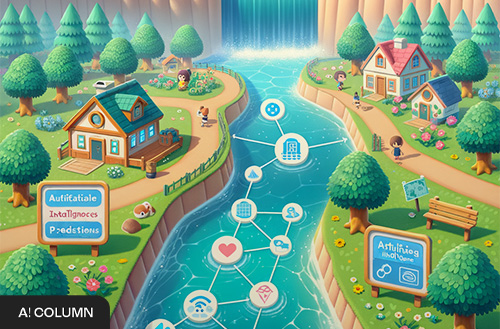

-
-
- 메일 공유
-
https://stories.amorepacific.com/en/amorepacific-how-much-water-did-you-drink-today
How Much Water Did You Drink Today?
On the Value of Water #3

Columnist
Sun-jin Ha Sustainability Management Center

#INTRO
Korea boasts many convenient and admirable customs. Among these, the ubiquity of water purifiers stands out as a favorite among foreign visitors. While many countries still rely on tap water for drinking, Korea offers water purifiers dispensing both cold and hot water at every turn. Some even produce ice! The temperature control makes it perfect for instant coffee or tea, and by reducing the need for plastic bottles, it's environmentally friendly, too. Offices typically provide water purifiers on each floor as an employee perk, a blessing for frequent water drinkers like myself. The trend of installing water purifiers at home is not just growing but booming, driven by concerns about water quality and the allure of convenience. Korea's affordable water rates have also played a role, making it financially feasible for many households to adopt this technology. This leads me to wonder: How much purified water do we consume daily? Let's examine our daily water usage and its economic impact.

Source: DALL-E generated image
1 Calculating Daily Water Usage
Tracking where, how much, and in what ways we use water from morning until night can indeed feel unfamiliar. We use water so frequently and habitually in our daily lives that it becomes almost invisible. The water usage discussed here is not an exact measurement from a flow meter but rather an approximate estimate. Starting the day, I head to the swimming pool. Before entering the pool, I take a pre-swim shower, using roughly 50 liters. Although the exact amount of water used in the public pool is difficult to allocate to an individual, this portion is excluded from my calculation. After swimming, I take a refreshing shampoo and shower, assuming this uses about 100 liters. Upon arriving at the office, the first routine is to fill a water cup. I estimated that I consume about 1.5 liters of water daily for drinking purposes. Additionally, I predicted that preparing and cleaning up after meals in the company cafeteria would use around 15 liters. After work, I return home and prepare dinner, using approximately 10 liters for cooking and 50 liters for washing dishes. I also water my plants, and thanks to the measuring marks on the watering can, I know precisely that I use 0.5 liters. Next, I do the laundry. A washing machine typically consumes about 50 liters, so I include this in the total. For brushing teeth and other hygiene activities at work and home, I estimated using 2 liters and 5 liters, respectively. Summing up the water usage for the entire day, the total comes to 284 liters. Seeing the number in the hundreds made me feel a bit guilty about my unintentional consumption. This is roughly equivalent to 15 of the standard blue PC water bottles (19 liters each) commonly used in water coolers, prompting me to reflect on whether I have been using water as if it were limitless.
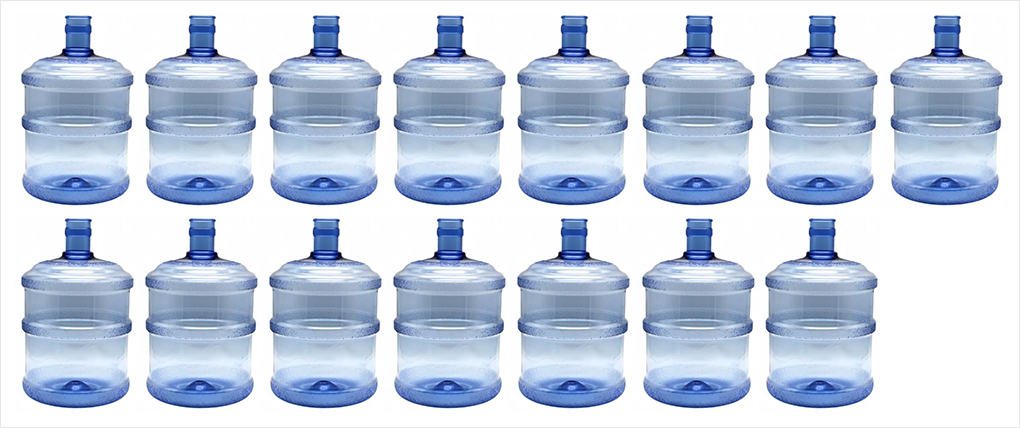
Daily Water Usage Converted to Water Cooler Bottles
Let's translate this into cost. Korea is renowned for its low water rates. According to Global Water Intelligence (GWI), a UK-based water research firm, the average water rate in significant countries is about 1,928 won per ton (m³). In 2022, Korea's average was just 748 won—a mere 38.8% of the global average. For comparison, rates in the UK, US, and Japan are 4.56, 3.73, and 1.64 times higher than Korea's, respectively. At Korea's average rate, my estimated daily usage of 284 liters costs about 212 won. That's roughly 6,400 won monthly or 76,000 won annually—hardly a burden on household finances. Indeed, since 2012, while the consumer price index has risen by 21.6%, the price of purified water has increased by only 9.8%. How does Korea maintain such competitive water prices? The country invests in efficiency improvements like leak detection, pipe modernization, and large-scale public management of water infrastructure. Government investment and subsidies prevent costs from being directly passed to consumers. Municipalities offer water fee reductions for vulnerable groups and rural areas to ensure universal access to essential water services. While future price adjustments may occur, the current water pricing structure has undoubtedly contributed to quality of life and national competitiveness.
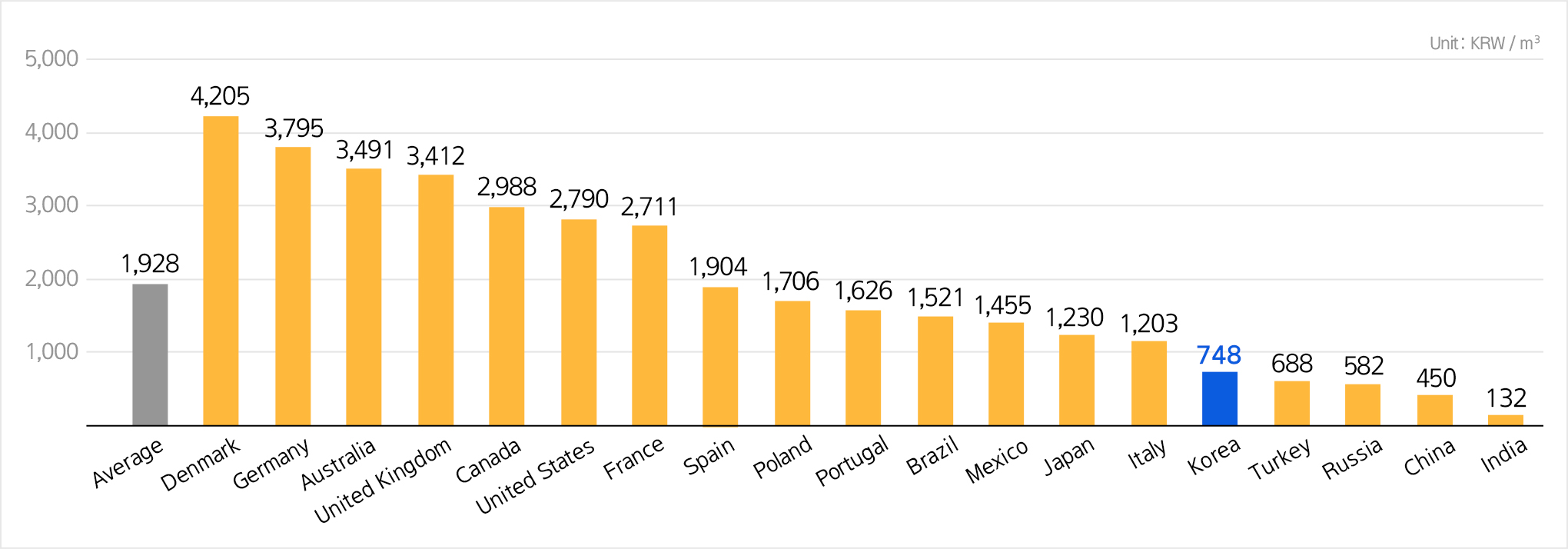
Water Rates in Major Foreign Countries (based on 2023 GWI statistics) / Source: K-water
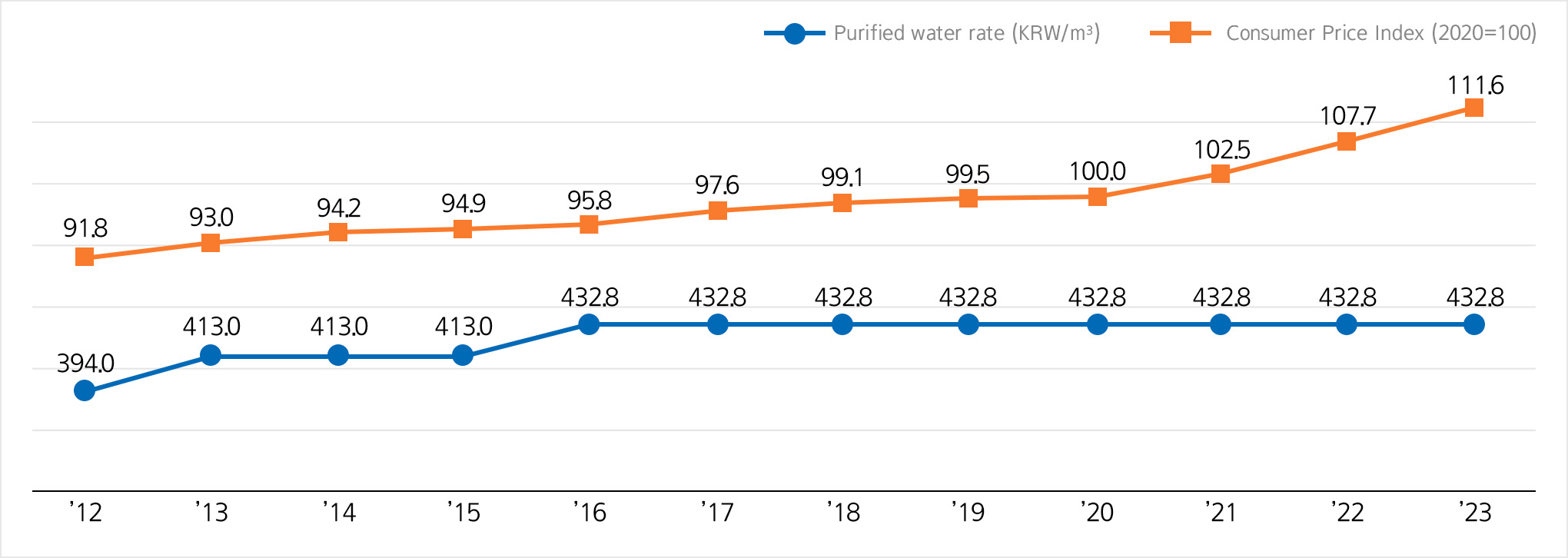
Comparison of Purified Water Rates and Consumer Price Index / Source: K-water
2 The Polarization of Water: Droughts and Floods
The comfort we derive from low water rates and easy access to water could be shattered by sudden climate changes leading to water scarcity, severely disrupting our daily lives. Indeed, some nations are already grappling with extreme droughts, forcing them to regulate household water usage. California, which endured its worst drought from 2012 to 2016, implemented region-specific water conservation targets as part of its drought risk management strategy. This starkly contrasts its past, when spring snowmelt from the mountains adequately filled reservoirs, sustaining the population throughout the year. California isn't alone in this struggle. Texas and Nevada have also introduced measures prohibiting or discouraging residential pool use, water-based cleaning, and car washing during drought. In Spain's Catalonia region, reservoir capacity plummeted to 14% across the province, with the second-largest reservoir, ‘Sau,’ virtually disappearing at a mere 1% capacity. Consequently, Catalonian households now face fines of up to 50 euros for using water for car washing, pool maintenance, or garden care. The European Commission reports that about 58% of European territory is experiencing water scarcity, portending even hotter summers ahead. In 2022, southern France faced a dire situation when rivers adjacent to water sources dried up, and reservoirs ran empty, cutting off the water supply to over 100 cities and towns. Communities resorted to trucking in water for household use, with some areas limiting individual water consumption to 200 liters per day. The arid land and desiccated trees became fuel for wildfires, incinerating hundreds of square meters of precious forests, painting a bleak picture of water scarcity.
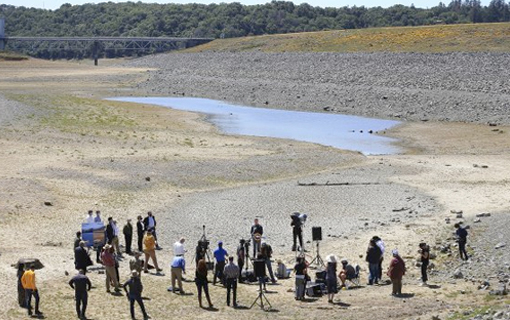
The Dried-up Basin of Lake Mendocino in Ukiah, California, 2021
/ Source:fnnews.com

Boat Mooring Area in Gelderland Province, Netherlands
/ Source:chosun.com
The sole remedy for such droughts is rainfall to moisten the earth. In the 21st century, we empathize with our ancestors, who performed rain rituals. However, when intense rain falls in too short a span, it fails to permeate the ground sufficiently, leading to floods. Eastern Australia experienced devastating floods in 2022, attributed to La Niña, an abnormal climate phenomenon where equatorial eastern Pacific temperatures cool while western Pacific temperatures rise. Four times over 18 months, this pattern's recurrence affected those directly hit by floods and the broader population. Insurance payouts for natural disasters spiked, driving up health and auto insurance premiums, while agricultural produce prices soared. In the same year, Pakistan experienced devastating floods that submerged one-third of the country, displacing countless residents. These floods were caused by sudden and intense monsoon rains, affecting Pakistan and neighboring Asian regions. This phenomenon, also known as the “Monster Monsoon,” refers to seasonal winds generated by temperature differences between the sea and land. Similar to the monsoon season in Korea, during the summer, the sea’s moisture-laden air is carried inland by winds, resulting in prolonged rainfall. Due to climate change, Pakistan's air, which had been holding temperatures above 50°C since spring, was laden with hot moisture. When this met with a low-pressure trough from the west, it triggered torrential downpours, according to researchers. Other climate scientists argue that the extreme heat caused glaciers in the mountainous regions to melt, swelling the nearby Indus River with additional water. The plight of displaced residents due to severe droughts and floods worldwide underscores the stark reality that no place is truly safe from such extreme weather events.
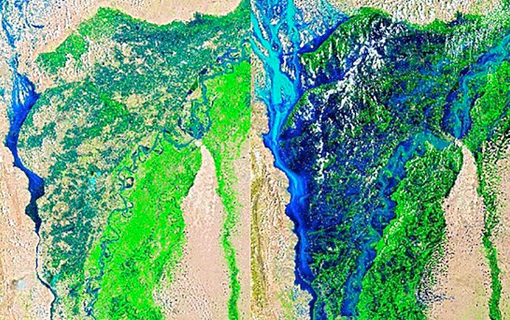
Near the Indus River in Pakistan, Before and After the Monsoon
/ Source:joongang.co.kr
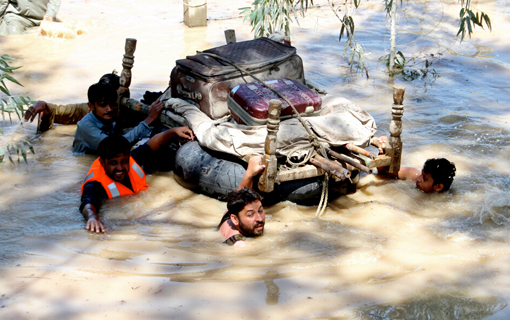
Southern Pakistan During the Monsoon Rainy Season, Late August 2022
/ Source:h21.hani.co.k
South Korea, too, has not been immune to droughts and floods. In the summer of 2022, while the capital region experienced disruptive heavy rains that paralyzed subways and roads, the southern areas paradoxically suffered from severe drought. The South Coast and South Jeolla Province, typically rainy areas, recorded their lowest precipitation since weather observations began in Korea, devastating field crops and orchards. Cumulative rainfall in Gwangju and South Jeolla reached only 60% of the average, resulting in a drought that persisted for over 280 days. May, crucial for spring farming, saw rain on only three days, leaving farmers distressed as even sporadic spring showers failed to alleviate the ongoing drought. Without acknowledging and adequately preparing for extreme climate scenarios like prolonged droughts, concentrated downpours, and significant temperature fluctuations, we risk repeated devastation and disruption to our daily lives. Is there a way to predict droughts or floods for crisis response? How can we learn about proper conduct during such disasters or monitor the status of domestic and industrial water supplies for our homes and businesses? Fortunately, all water-related information is available through various government-provided information systems.
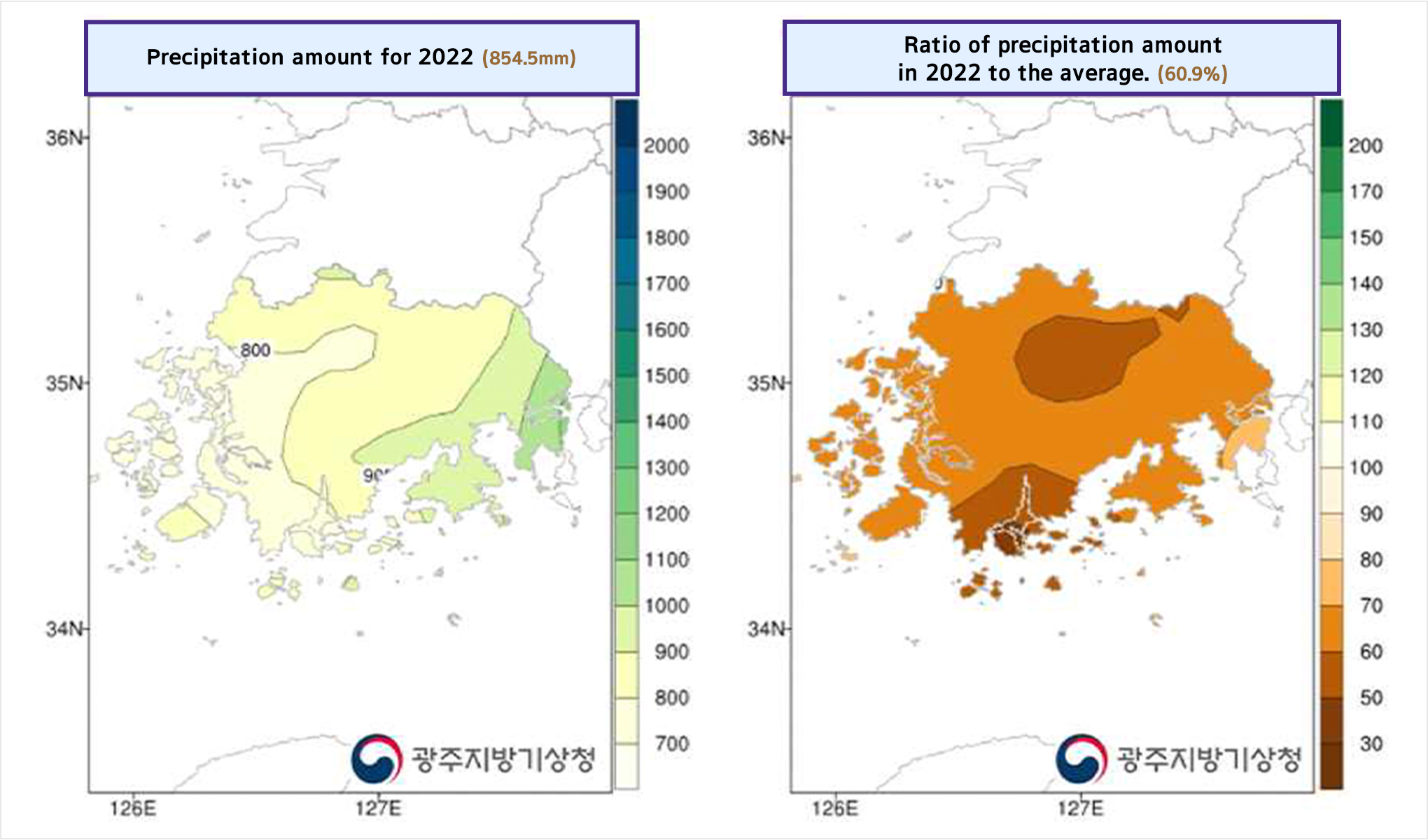
Annual Precipitation in South Jeolla and Gwangju Regions for 2022 (left) and Average Year Precipitation Distribution (right) / Source: Gwangju Regional Meteorological Administration
3 Easily Examining Water Resource Status
Having discussed household water usage and water-related disasters, let's explore methods for preparing for and preventing natural calamities like droughts and floods. In Korea, some websites offer a comprehensive view of the water environment and statistical data collected from various locations based on geographical information. Notable examples include the Water Environment Information System and regional Flood Control Offices. These platforms provide valuable information on disaster, response methods, water-related issues, and technological trends that households and businesses can utilize.
1) Water Resources Management Information System (WAMIS)
The Water Resources Management Information System (WAMIS) is a platform that integrates Korea's water resource data. This system provides real-time monitoring of crucial water resource information such as river conditions, weather, dam operations, water quality, and water usage status. It also offers various services, including flood prediction and drought situation updates. As an open platform accessible to the general public, it allows straightforward inquiry into nearby river basin levels and flow rates.
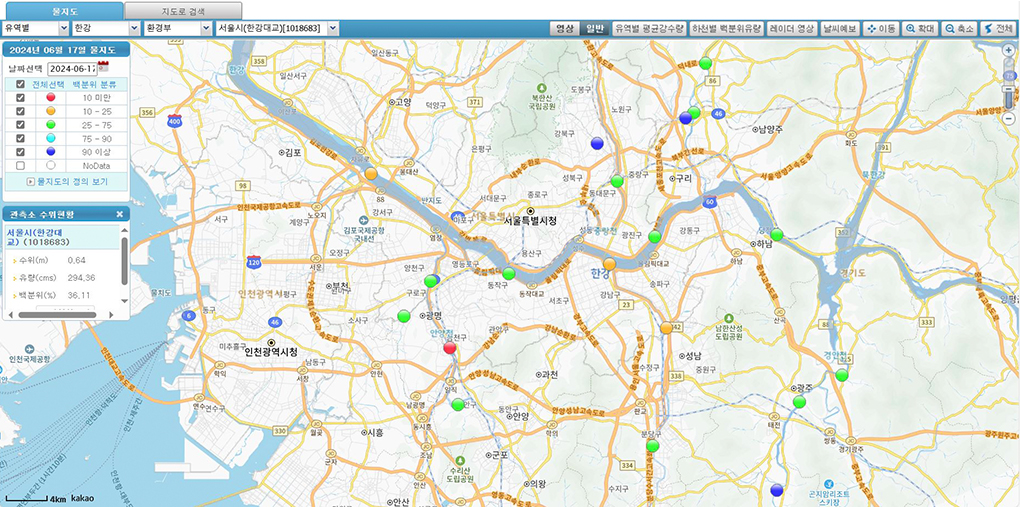
Water Map (Hangang Bridge Point) / Source:WAMIS
2) National Drought Information Portal
The National Drought Information Portal, operated by the Korea Meteorological Administration, is a platform providing information necessary for drought monitoring and prediction. This portal offers real-time updates on drought status, forecasts, related news, research findings based on scientific analysis, and response measures. It features a crucial function called "Low Water Status" that helps anticipate and prepare for drinking water crises in drought-vulnerable areas and agricultural water shortages. The portal also provides guidance on disaster insurance for cases where damage occurs despite drought preparedness.
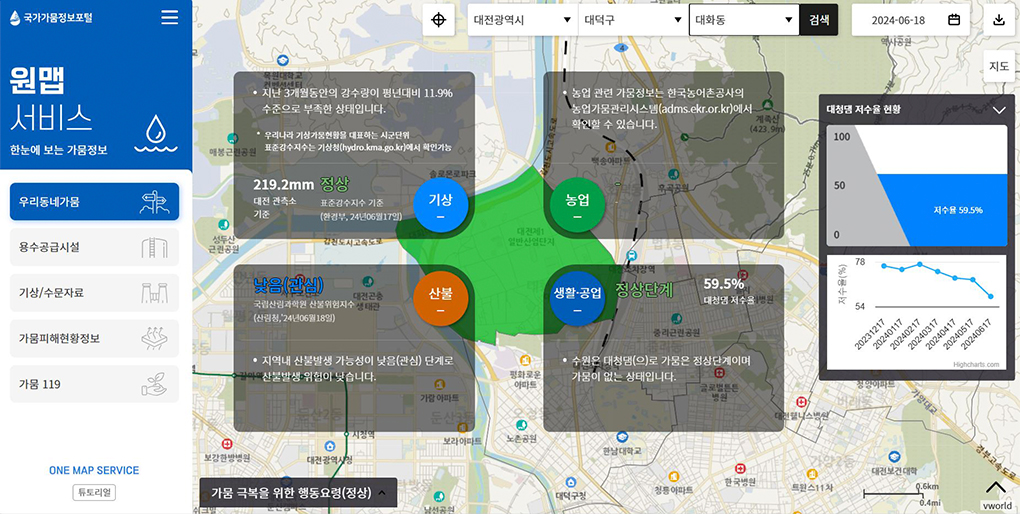
Source: drought.go.kr
3) WRI Aqueduct Water Risk Atlas
The WRI Aqueduct Water Risk Atlas is a tool the World Resources Institute (WRI) developed to map and assess global water resource risks. It evaluates current water risks and analyzes long-term water-related risks. Users can identify competitive water demands due to population growth or economic development, impacts based on climate change scenarios, and seasonal water risks. This tool will help develop strategies to predict and prepare for water risks from 2030 to 2080.
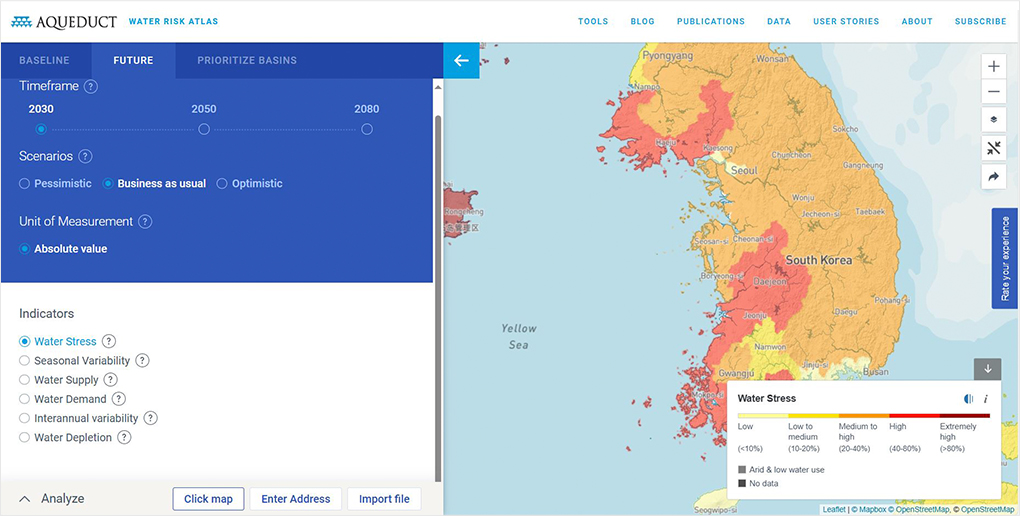
2030 Water Stress Areas Analyzed Through the Aqueduct Water Risk Atlas / Source:Aqueduct
#OUTRO
As you sip a glass of water from your convenient water purifier, you might find the content of today's column a bit heavy. With temperatures projected to rise and scientific predictions of abnormal climate events increasing, we cannot avoid disasters entirely. However, rather than succumbing to anxiety, it seems prudent to adapt and prepare appropriately. For families with children on vacation, checking your local water quality monitoring network through the Water Environment Dashboard of the Water Environment Information System or visiting ecological travel sites near rivers and lakes, as introduced on the My Water, might be worthwhile. In the next episode, we'll explore how AI and other technologies synergize with water to keep pace with rapidly changing times.
-
Like
0 -
Recommend
0 -
Thumbs up
0 -
Supporting
0 -
Want follow-up article
0





